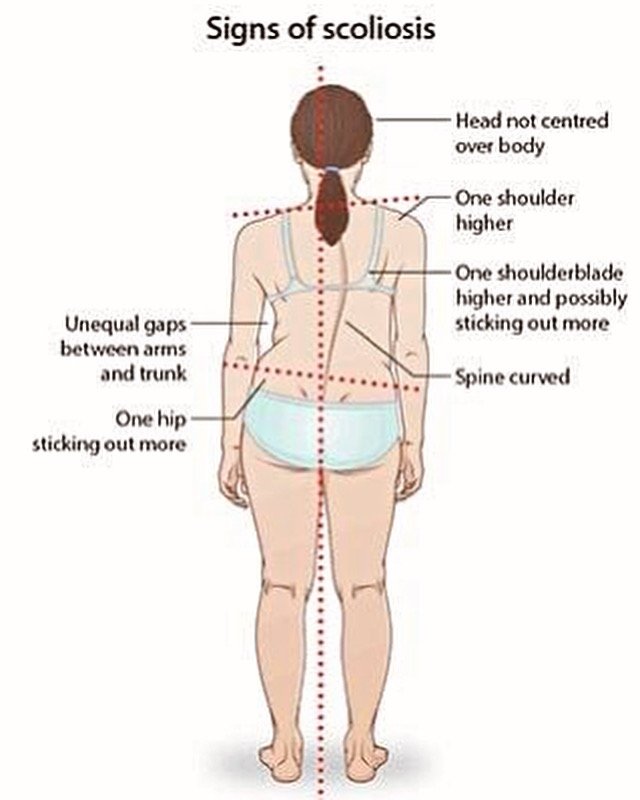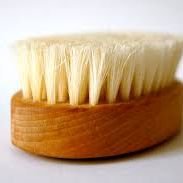Don’t mind my feet! But do you mind your feet?
I’m just opening up the neural gaps, increasing circulation, and improving the communication pathway from my feet to my brain.
Unless you go out of your way to shop for a shoe with a wide shoe box, not to be confused with a wide shoe, your footwear is compressing your toes.
Weak feet give you a poor foundation for your joints above, so adding footwork into your practice is always a good idea.
My son has been asking for toe separators after seeing my various toe socks. They can be worn for a few minutes initially to build up your comfort level. These will help your balance and foot pain.
If you’d like to receive my list of Healthy Foot Tips, send me an email, so I can share it with you.
National Scoliosis Awareness Month
June is National Scoliosis Awareness month.
Increasing awareness may happen through:
* education about the prevalence of scoliosis
* encouraging screening for early detection
* supporting our fellow scoliosis warriors within this community
I had a good time this morning supporting my fellow scoliosis and fusion warriors by teaching my workshop: Scoliosis & Fusion Daily Yoga.
I will be sharing many of my thoughts on this topic throughout this month. Let me know what thoughts or questions come up for you?
Signs of Scoliosis
My mild childhood scoliosis became visible when I was trying on bathing suits for Spring Break when I was a freshman in high school. If you wear baggy clothing as I did at the time, it can be difficult to notice some of the signs of scoliosis. For this reason, scoliosis can be easily missed by parents, caregivers, and even doctors.
If you have reason to suspect scoliosis—for example, your child was told that they had a ‘mild’ curve when they were younger—take a moment to look at their back periodically. If you suspect scoliosis, ask your doctor for an evaluation. Even if a child is active, they don’t “grow out” of scoliosis in time or by participating in sports.
Many public schools no longer provide scoliosis screening.
Early detection offers more treatment options.
True or False?
I have to ask this question because I commonly hear comments about not being able to do yoga because the person can’t touch their toes.
But here’s the thing... The only prerequisite for practicing yoga is that you are able to breathe.
At the end of the day, we all have some compression from the effects of gravity. Those who are more flexible are more likely to collapse in their curves and further compress the collapsed (concavities) areas of their back. Instead, our goal is to stay upright and elongated, and we do that by working on our control and stability of the spine.
A new client called himself a “skeptic” until he actually tried yoga, and then realized that it truly did help with aches and pains.
Scoliosis and Fusion Friendly Back Strengthening
This pose may be called:
4-point Stabalization
Tricky Cat
Bird Dog
This pose is great for strengthening your back and core muscles, as well as challenging your balance. Don’t progress until you feel you have the strength to maintain length and expansion in these variations. You may repeat these movements as you build your strength, and also practice longer holds.
Do you see a stack of books, or scoliotic vertebrae?
The vertebrae don't only move to the right or left of the midline due to scoliosis, but they also rotate toward the back body or the front body. There's a lot going on in the body, and it can change in each segment of the body, so the shoulder region may be opposite of what's happening in the lower back. We are beautifully complicated.
Just like a snowflake, nobody has curves that are created exactly the same. It's a process to learn what's going on in your own body.
Want to learn more in order to feel more balanced in your body? You may join a class, schedule a private session, or let me know if you want to have a phone call first.
Happy 29th Surgiversary!
Wow, 29 years since I had my spinal fusion surgery!
I'm proud of what I've tackled and overcome during this time, and yoga played a huge role in the process, as it will for decades to come.
A couple weeks ago, I watched a webinar by Setting Scoliosis Straight. Doctors from around the world shared their research on Long-Term Follow Up on Adolescent Idiopathic Scoliosis. Most doctors shared research on 10-years post-op, but one doctor from Spain shared a study that his mentor conducted on over 100 patients that had a spinal fusion surgery in the 1980's, so about 30-years prior. You may view this webinar on YouTube now, and I hope to see more long-term studies like this in the future.
Movement is key for EVERY BODY, so we need to find what we enjoy and can maintain.
What do YOU want to know about yoga and scoliosis or spinal fusion?
One of the reasons I decided to return to teaching yoga back in 2019 was to also make a commitment to myself. Sure, I could continue to do what I already knew about yoga and scoliosis, but I would be more committed to continuous learning if I were teaching students. My practice and teaching definitely evolve over time, and that's the best part of keeping that inner spark alive.
There's a saying about the ultimate form of learning is to teach. So that leads me to asking what you'd like to learn from me? No question is too small or too silly! Let me know what you'd like to learn, and I'll do my best to answer.
You know what the teacher used to always say? If you have a question, someone else has the same question, too!
What are chain reactions in the body?
It's the process of one movement triggering another movement in the body, such as the ripple effect when throwing a pebble into a pond. The same thing happens in the body when we take a movement in one part of the body, and that movement extends and expands throughout the body. However, this exaggerates when there's a limitation in one part of the body, and the brain will take the movement to another part of the body. This limitation could be due to tight hips, shoulder range of motion, hyperkyphosis, scoliosis, spinal fusion...
Why does this matter? It matters if these habitual chain reactions go on for years or decades, and eventually lead to chronic pain or postural issues.
Before I discovered a more mindful and alignment based approach to yoga, I was doing all sorts of yoga, and pretty well. I had practiced Ashtanga yoga for years, would do bird of paradise, wheel... yikes! I'm glad that I learned about what my chain reactions would lead to in my body. My biggest physical limitation is my fusion, and when I was practicing any x,y,z yoga pose, I was not taking into account that I was overburdening my unfused vertebrae. A goal of my practice is to feel good in my body, AND do what I can to prevent future surgeries.
Notice how you feel when you sit on the floor or reach your arms alongside your ears, for example. The outsider may say that your pose looks good, but ask yourself how it feels in your entire body.
The diaphragm
The diaphragm is the major muscle of respiration that sits below the lungs. Most of us are familiar with its dome shape, but did you know that it attaches to vertebrae in the lower thoracic and lumbar areas of the spine?
Breathing dysfunction can affect the whole body. When our diaphragmatic mobility decreases, we may have more tension and less mobility in the low back.
Our shoulders
Every time I'd get a massage, I'd tell the masseuse that my upper shoulders were tense. I thought this area being tense was unique to me until one time I was told that it was common. If you feel like your upper shoulders are tense, and your pectoral muscles are short, then you'll love Back Health class. We incorporate self massage and mobility work to feel this area in a new way.
Those of us with scoliosis, and a curve in the thoracic spine, may have uneven shoulders, a shoulder blade that wings out, or pain. Working on moving our shoulder blades on our ribcage can help with pain and keeping the shoulders healthy.
AWAKEN THE BACKSIDE
Our posterior chain refers to the muscles that make up the backside of our body, and are essential to our movement and stability, yet is an area that’s often overlooked. This chain spans from the soles of the feet, up the backs of the legs, the gluteus maximus, along the spine, and up to the crown of the head.
These muscles tend to be tight and weak from too much sitting, or from an imbalance in overtraining the front body. A strong posterior chain is important in overall health, keeping the body upright, and providing stability for the spine and hips. When these posterior chain muscles are weak, we can experience back pain, poor posture, or unstable balance.
Self-Care
It takes some time to figure out what helps bring you physical relief, and especially how to care for yourself in a way to not enter that zone, or have it happen less frequently.
Movement, breath, sleep, and diet are important factors to focus on when it comes to back pain. However, there's also small actions we can take, such as daily dry brushing, which are essentially free and just take a couple minutes.
About fifteen years ago, a holistic endocrinologist suggested that I try body brushing with a natural bristle brush. I thought I was supposed to almost scrub my skin, which didn't feel good. I never kept up the practice.
When I was pregnant, my stretched skin would feel itchy, and I found a lot of relief from gentle body brushing. Since my pregnancy, I've been dry brushing daily. This practice just felt good to me, and I didn't realize that it had other health benefits.
The dry brushing action stimulates circulation of blood and lymph, which is good for circulation. Dry brushing also stimulates the nerve endings in our skin, which is incredibly important in areas that are not getting the necessary stimulation to stay healthy, such as a painful area we aren't moving. The practice is soothing and may relieve pain for some people.
I do a soft dry brushing before getting in the shower, and prefer my brush with a long handle. I love the habit so much that I also have a smaller brush to take with me when I travel. I may have even brought it camping last summer.
Some added bonuses are the exfoliation for softer skin and a lift in energy.
Try out this self-massage technique and let me know what you think.














